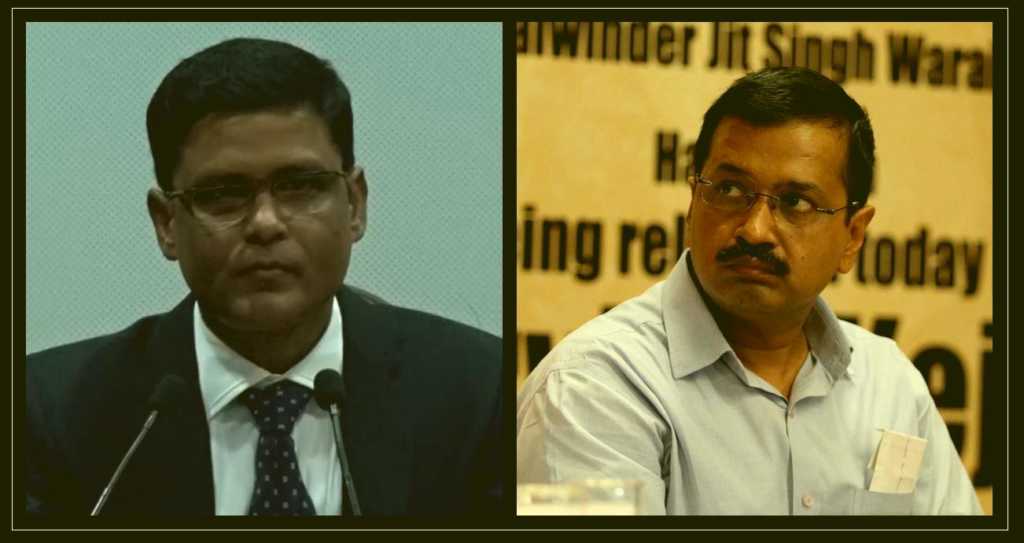It looks like the troubles for Aam Aadmi Party won’t end anytime soon. Already in the docks for having made life in Delhi difficult with his grossly negligent attitude towards the administration of Delhi, Arvind Kejriwal is now under criticism for scrapping up the Delhi BRT corridor, which was touted as an improvement in the decaying bus network of the national capital, leading to further deterioration of the air quality in Delhi NCR region.
While there were many voices supporting this decision only for the sake of cozying up to the alleged ‘Common Man’s Savior’, there were few voices who criticized this step and pointed out the flaws behind the decision to scrap the Delhi BRT corridor. But one man has finally stood up for both the BRT corridor and the improvement in Delhi’s horrible air quality.
Once the environmental secretary for the Delhi government for two consecutive terms, senior bureaucrat Shri Keshav Chandra has taken Arvind Kejriwal led Delhi government to the cleaners for scrapping the Delhi BRT corridor, rightly summing up their decision as ‘throwing out the baby with the bathwater.’
To quote him, the decision to scrap the 5.8-km- long stretch of the corridor was an act of pandering to the opinion of a vocal middle class, which has a “strong sense of entitlement”.
“The fault was not with the design. There was a communication gap. It was mainly due to a strong sense of entitlement of the middle class. This class has a stronger voice,” Mr. Chandra said on Friday while delivering a talk on the pollution crisis as part of the ‘Delhi Matters’ series.
He was referring to the shrill criticism of the car owners that the bus corridor was behind traffic jams along the route, an angle that was routinely played up by a section of the media leading to its eventual dismantling in January 2016. Mr. Chandra also asserted said the city needs around 11,000 buses as against the existing fleet of barely 5,000.
“… It (the BRT corridor) was the most progressive step against air pollution,” he said about the corridor, which was conceptualized and built by the Sheila Dikshit-led Congress government in 2008 at a cost of around Rs. 150 crores.
But what is Delhi BRT Corridor? Why its scrapping is the hot potato in the current political scenario? This is because this corridor, which is actually a rapid bus transit network, aimed to give more teeth to the then emerging public transport in Delhi, which had significantly reduced by 2007. Launched in 2008, as a program with a view to improve both the transportation and the air quality in the run up to the 2010 Commonwealth Games, which was to be held in New Delhi.
So if the Delhi BRT Corridor was so useful, why was it scrapped? While there are several reasons that were instrumental in the poor implementation of the noble initiative, following three were the most severe causes that made a laughing stock of the Delhi BRT corridor:-
1.) Lack of Strong Enforcement, i.e. the network of buses was poorly implemented
2.) Difficulty in accessing Bus Platforms, i.e. the bus commuters had a tough time in boarding the buses, which often stopped in the middle of the road
3.) Longer Traffic Signal Cycle Times, i.e. a disruption in the smooth run of the traffic
However, while these causes are reason enough to prove that something wasn’t right with the Delhi BRT corridor, scrapping the system altogether isn’t something what you would call as sensible. Would you shoot a person to death, just because he/she suffers from some chronic fever? No, but that’s exactly what Kejriwal government did.
Instead of rectifying the flaws that were prevalent in the BRT corridor, Arvind Kejriwal scrapped the entire corridor altogether, without even caring for the disastrous repercussions that would follow.
Funnily enough, the decision, which was approved by AAP government in July 2015, stands in clear violation of their own promise of expanding the bus services throughout Delhi, in order to ease both the problem of commutation to office work, as well as the pollution prevalent in Delhi. Following is what AAP promised in their own manifesto that was launched before the Delhi Legislative Assembly Elections, which were held in 2015:-
Forget an expansion in the fleet of buses; Aam Aadmi Party has not even added a single bus to the dying Delhi bus service, which has reduced to merely 3775 buses, as of October 2016. The Aam Aadmi Party, which had boasted of making Delhi a better place to live, has only made it worse to even breathe in, causing a worldwide embarrassment to India’s national capital. Incidents like the Sri Lankan cricket team wearing masks [though it was more for publicity rather than protesting on a serious note] have only rubbed salt into the wounds that Delhi is suffering for electing the ex IRS officer and his cronies to power in 2015.
Also, for those, who think that this is pure rhetoric, the protection of Delhi as a city and an NCR, is purely under the ambit of the incumbent government. So if Delhi is reeling under the after effects of the smog and heavy pollution, it is chiefly the Arvind Kejriwal government that is responsible. If the Municipal Corporation of Delhi is not implementing the decisions, it is the Delhi government who should take strict action, instead of passing the buck on the Central government.
While Keshav Chandra’s criticism of scrapping the Delhi BRT corridor may look like political vendetta, the truth is that his criticism is only the tip of the iceberg, and unless the Kejriwal government pulls up their socks real tight, this iceberg can sink the ship of their government in the upcoming elections of 2020. The citizens of Delhi are watching.
